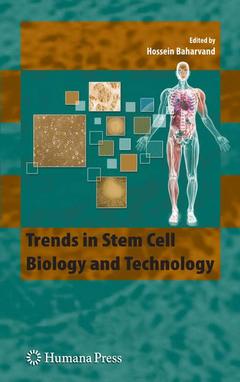Description
Trends in Stem Cell Biology and Technology, Softcover reprint of the original 1st ed. 2009
Coordinator: Baharvand Hossein
Language: English
Subjects for Trends in Stem Cell Biology and Technology:
Keywords
Tissue Engineering; bone; cell biology; cell lines; cells; regenerative medicine; tissue
116,04 €
Disponible chez l'éditeur (délai d'approvisionnement : 15 jours).
Add to cart
Trends in Stem Cell Biology and Technology
Publication date: 08-2016
Support: Print on demand
Publication date: 08-2016
Support: Print on demand
Trends in stem cell biology & technology
Publication date: 06-2009
425 p. · 15.5x23.5 cm · Relié
Publication date: 06-2009
425 p. · 15.5x23.5 cm · Relié
Résumé
/li>Sommaire
/li>Commentaire
/li>
Stem cells, characterized by the ability to both self-renew and to generate diff- entiated functional cell types, have been derived from the embryo and from va- ous sources of the postnatal animals and human. The recent advances in stem cell research have led to a better understanding of self-renewal, maintenance, and diff- entiation of both embryonic and somatic stem cells. This has significantly increased our knowledge of cellular and developmental biology in general and will certainly continue to do so for a long time to come. Moreover, given their role in maintaining and replenishing tissues, stem cells represent a potential means of restoring tissue function and thereby treating the root cause of degenerative disease. Therefore, in parallel, we need to improve our cognizance of the challenges involved in applying stem cells in clinical settings. The current chapters highlight both of these aspects: that of understanding the ?actual? and that of developing the ?possible. ? In recognition of the growing excitement and potential of stem cells as models for both the advancement of basic science and future clinical applications, I felt it timely to edit this book in which forefront investigators would provide new findings for the use of stem cells to study various lineages and tissue types and some app- cations.
Human Embryonic Stem Cells: Their Nature, Properties, and Uses.- Production of Uniparental Embryonic Stem Cell Lines.- Parthenogenetic Embryonic Stem Cells in Nonhuman Primates.- Nuclear and Somatic Cell Genetic Reprogramming.- Reprogramming Male Germ Cells to Pluripotent Stem Cells.- Pluripotent Stem Cell Epigenetics During Development and Cancer.- Observing and Manipulating Pluripotency in Normal and Cloned Mouse Embryos.- Current Developments in Genetically Manipulated Mice.- Differentiating Gametes from Stem Cells.- Spermatogonial Stem Cells.- Regulated Transcripts and Coregulated microRNAs in Male Spermatogonial Stem Cells.- Human Mesenchymal Stem Cells: Basic Biology and Clinical Applications for Bone Tissue Regeneration.- Clinical Cell Therapy for Heart Disease.- Embryonic Stem Cells, Cardiomyoplasty, and the Risk of Teratoma Formation.- Neural Differentiation of Human Embryonic Stem Cells and Their Potential Application in a Therapy for Sensorineural Hearing Loss.- Stem Cell Transplantation Supports the Repair of Injured Olfactory Neuroepithelium After Permanent Lesion.- Strategies Toward Beta-Cell Replacement.- Corneal Epithelial Stem Cells and Their Therapeutic Application.- Tissue Engineered Scaffolds for Stem Cells and Regenerative Medicine.- Mechanotransduction and Its Role in Stem Cell Biology.
Geared to undergraduates, postgraduates, stem cell biologists, tissue engineers, medical doctors, and scientists with an interest in stem cell research and therapeutic purposes The text is very comprehensive and covers new aspects of stem cell research Many of the chapters carry extensive self-explanatory figures, graphics, and tables Includes supplementary material: sn.pub/extras
© 2024 LAVOISIER S.A.S.
Ces ouvrages sont susceptibles de vous intéresser

The Cell Biology of Stem Cells 158,24 €

Stem CellsTherapeutic Applications 189,89 €


